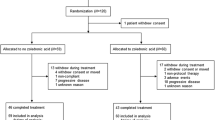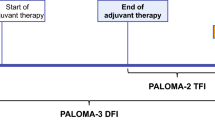Abstract
The study investigated the anti-tumour effect of zoledronic acid (ZA) administered alone in a biological window therapy in naïve bone-only metastatic and locally advanced breast cancer (LABC) patients. 33 patients with LABC (Group 1) and 20 patients with a first diagnosis of bone metastasis only (Group 2) received 4 mg single dose of ZA, 14 days (biological window) before starting any treatment. In Group 1, Ki67, CD34, p53/bcl-2 and caspase 3 expression along with the adenosine triphosphate (ATP) levels and RNA disruption index were evaluated as markers of tumor growth in tumour specimens obtained before and after ZA administration (basal, day 14). In Group 2, the total enumeration of circulating tumour cells (CTCs), and of M30+ve CTCs along with the soluble marker of cell death (M30/M65) were carried-out as markers of tumor dissemination at baseline, at 48 h and day 14th. In Group 1, there was a significant reduction in Ki67, CD34, bcl-2 expression after 14 days ZA based-treatment (p = 0.0032; p = 0.0001, p < 0.00001 respectively). ZA showed a significant increase of RNA disruption (p < 0.0076). In Group 2, we observed a significant reduction of CTCs number after 48 h (p = 0.0012), followed by a significant rebound at 14 days (p = 0.012). The apoptotic CTCs/M30+ve and M65 levels significantly increased under treatment (p = 0.018 and p = 0.039 respectively) after drug administration when compared to the baseline. These results are the first prospective in vivo data showing the direct pure anti-tumour effect (either on the tumour cell or on CTCs) of ZA.





Similar content being viewed by others
References
Manders K, van de Poll-Franse LV, Creemers GJ, Vreugdenhil G, van der Sangen MJ, Nieuwenhuijzen GA et al (2006) Clinical management of women with metastatic breast cancer: a descriptive study according to age group. BMC Cancer 6:179
Braun S, Pantel K, Muller P, Janni W, Hepp F, Kentenich CR et al (2000) Cytokeratin-positive cells in the bone marrow and survival of patients with stage I, II, or III breast cancer. N Engl J Med 342:525–533
Cristofanilli M (2006) Circulating tumor cells, disease progression, and survival in metastatic breast cancer. Semin Oncol 33:S9–S14
Sceneay J, Smyth MJ, Moller A (2013) The pre-metastatic niche: finding common ground. Cancer Metastasis Rev. doi:10.1007/s10555-013-9420-1
Kingsley LA, Fournier PG, Chirgwin JM, Guise TA (2007) Molecular biology of bone metastasis. Mol Cancer Ther 6:2609–2617
Zoccoli A, Iuliani M, Pantano F, Imperatori M, Intagliata S, Vincenzi B et al (2012) Premetastatic niche: ready for new therapeutic interventions? Expert Opin Ther Targets 16(Suppl 2):S119–S129
Clezardin P (2005) Anti-tumour activity of zoledronic acid. Cancer Treat Rev 31(Suppl 3):1–8
Gnant M, Clezardin P (2012) Direct and indirect anticancer activity of bisphosphonates: a brief review of published literature. Cancer Treat Rev 38:407–415
Neville-Webbe HL, Evans CA, Coleman RE, Holen I (2006) Mechanisms of the synergistic interaction between the bisphosphonate zoledronic acid and the chemotherapy agent paclitaxel in breast cancer cells in vitro. Tumour Biol 27:92–103
Ottewell PD, Monkkonen H, Jones M, Lefley DV, Coleman RE, Holen I (2008) Antitumor effects of doxorubicin followed by zoledronic acid in a mouse model of breast cancer. J Natl Cancer Inst 100:1167–1178
Santini D, Vincenzi B, Dicuonzo G, Avvisati G, Massacesi C, Battistoni F et al (2003) Zoledronic acid induces significant and long-lasting modifications of circulating angiogenic factors in cancer patients. Clin Cancer Res 9:2893–2897
Jagdev SP, Coleman RE, Shipman CM, Rostami HA, Croucher PI (2001) The bisphosphonate, zoledronic acid, induces apoptosis of breast cancer cells: evidence for synergy with paclitaxel. Br J Cancer 84:1126–1134
Kunzmann V, Bauer E, Feurle J, Weissinger F, Tony HP, Wilhelm M (2000) Stimulation of gammadelta T cells by aminobisphosphonates and induction of antiplasma cell activity in multiple myeloma. Blood 96:384–392
Aft R, Perez JR, Raje N, Hirsh V, Saad F (2012) Could targeting bone delay cancer progression? Potential mechanisms of action of bisphosphonates. Crit Rev Oncol Hematol 82:233–248
Coleman RE, Winter MC, Cameron D, Bell R, Dodwell D, Keane MM et al (2010) The effects of adding zoledronic acid to neoadjuvant chemotherapy on tumour response: exploratory evidence for direct anti-tumour activity in breast cancer. Br J Cancer 102:1099–1105
Gnant M, Mlineritsch B, Stoeger H, Luschin-Ebengreuth G, Heck D, Menzel C et al (2011) Adjuvant endocrine therapy plus zoledronic acid in premenopausal women with early-stage breast cancer: 62-month follow-up from the ABCSG-12 randomised trial. Lancet Oncol 12:631–641
Coleman R, Gnant M, Morgan G, Clezardin P (2012) Effects of bone-targeted agents on cancer progression and mortality. J Natl Cancer Inst 104:1059–1067
Bottini A, Berruti A, Bersiga A, Brizzi MP, Bruzzi P, Aguggini S et al (2001) Relationship between tumour shrinkage and reduction in Ki67 expression after primary chemotherapy in human breast cancer. Br J Cancer 85:1106–1112
Nakopoulou L, Alexandrou P, Stefanaki K, Panayotopoulou E, Lazaris AC, Davaris PS (2001) Immunohistochemical expression of caspase-3 as an adverse indicator of the clinical outcome in human breast cancer. Pathobiology 69:266–273
Fumarola C, La Monica S, Guidotti GG (2005) Amino acid signaling through the mammalian target of rapamycin (mTOR) pathway: role of glutamine and of cell shrinkage. J Cell Physiol 204:155–165
Cristofanilli M, Budd GT, Ellis MJ, Stopeck A, Matera J, Miller MC et al (2004) Circulating tumor cells, disease progression, and survival in metastatic breast cancer. N Engl J Med 351:781–791
Rossi E, Basso U, Celadin R, Zilio F, Pucciarelli S, Aieta M et al (2010) M30 neoepitope expression in epithelial cancer: quantification of apoptosis in circulating tumor cells by Cell Search analysis. Clin Cancer Res 16:5233–5243
Come PC, Come SE, Hawley CR, Gwon N, Riley MF (1982) Echocardiographic manifestations of carcinoid heart disease. J Clin Ultrasound 10:233–237
Coleman RE, McCloskey EV (2011) Bisphosphonates in oncology. Bone 49:71–76
Coleman RE, Marshall H, Cameron D, Dodwell D, Burkinshaw R, Keane M et al (2011) Breast-cancer adjuvant therapy with zoledronic acid. N Engl J Med 365:1396–1405
Gnant M, Mlineritsch B, Schippinger W, Luschin-Ebengreuth G, Postlberger S, Menzel C et al (2009) Endocrine therapy plus zoledronic acid in premenopausal breast cancer. N Engl J Med 360:679–691
Winter MC, Wilson C, Syddall SP, Cross SS, Evans A, Ingram CE et al (2013) Neoadjuvant chemotherapy with or without zoledronic acid in early breast cancer–a randomized biomarker pilot study. Clin Cancer Res 19:2755–2765
Dowsett M, Nielsen TO, A’Hern R, Bartlett J, Coombes RC, Cuzick J et al (2011) Assessment of Ki67 in breast cancer: recommendations from the International Ki67 in Breast Cancer working group. J Natl Cancer Inst 103:1656–1664
Ottewell PD, Woodward JK, Lefley DV, Evans CA, Coleman RE, Holen I (2009) Anticancer mechanisms of doxorubicin and zoledronic acid in breast cancer tumor growth in bone. Mol Cancer Ther 8:2821–2832
Brenner C, Grimm S (2006) The permeability transition pore complex in cancer cell death. Oncogene 25:4744–4756
Garrido C, Galluzzi L, Brunet M, Puig PE, Didelot C, Kroemer G (2006) Mechanisms of cytochrome c release from mitochondria. Cell Death Differ 13:1423–1433
Cande C, Cohen I, Daugas E, Ravagnan L, Larochette N, Zamzami N et al (2002) Apoptosis-inducing factor (AIF): a novel caspase-independent death effector released from mitochondria. Biochimie 84:215–222
Kuroda J, Kimura S, Segawa H, Sato K, Matsumoto S, Nogawa M et al (2004) p53-independent anti-tumor effects of the nitrogen-containing bisphosphonate zoledronic acid. Cancer Sci 95:186–192
Fehm T, Zwirner M, Wallwiener D, Seeger H, Neubauer H (2012) Antitumor activity of zoledronic acid in primary breast cancer cells determined by the ATP tumor chemosensitivity assay. BMC Cancer 12:308
Solomayer EF, Gebauer G, Hirnle P, Janni W, Luck HJ, Becker S et al (2012) Influence of zoledronic acid on disseminated tumor cells in primary breast cancer patients. Ann Oncol 23:2271–2277
Chang J, Ormerod M, Powles TJ, Allred DC, Ashley SE, Dowsett M (2000) Apoptosis and proliferation as predictors of chemotherapy response in patients with breast carcinoma. Cancer 89:2145–2152
Archer CD, Parton M, Smith IE, Ellis PA, Salter J, Ashley S et al (2003) Early changes in apoptosis and proliferation following primary chemotherapy for breast cancer. Br J Cancer 89:1035–1041
Lin JH (1996) Bisphosphonates: a review of their pharmacokinetic properties. Bone 18:75–85
Chen T, Berenson J, Vescio R, Swift R, Gilchick A, Goodin S et al (2002) Pharmacokinetics and pharmacodynamics of zoledronic acid in cancer patients with bone metastases. J Clin Pharmacol 42:1228–1236
Cummings J, Ward TH, LaCasse E, Lefebvre C, St-Jean M, Durkin J et al (2005) Validation of pharmacodynamic assays to evaluate the clinical efficacy of an antisense compound (AEG 35156) targeted to the X-linked inhibitor of apoptosis protein XIAP. Br J Cancer 92:532–538
Leist M, Single B, Naumann H, Fava E, Simon B, Kuhnle S et al (1999) Inhibition of mitochondrial ATP generation by nitric oxide switches apoptosis to necrosis. Exp Cell Res 249:396–403
Acknowledgments
This study was partly funded by Associazione Ricerca in Campo Oncologico Onlus, Cremona, Italy
Author information
Authors and Affiliations
Corresponding author
Rights and permissions
About this article
Cite this article
Foroni, C., Milan, M., Strina, C. et al. Pure anti-tumor effect of zoledronic acid in naïve bone-only metastatic and locally advanced breast cancer: proof from the “biological window therapy”. Breast Cancer Res Treat 144, 113–121 (2014). https://doi.org/10.1007/s10549-014-2840-y
Received:
Accepted:
Published:
Issue Date:
DOI: https://doi.org/10.1007/s10549-014-2840-y




